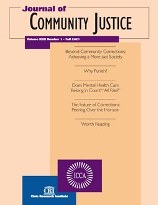Complete Issue
Author: Don Evans.
Source: Volume 18, Number 04, Summer 2009 , pp.1-24(24)

< previous article |return to table of contents
Abstract:
At the heart of the correctional enterprise is the rather narrow gate of admission that leads from our halls of justice to our corridors of punishment (or, in an enlightened era, to treatment). This gate is known as the sentencing process, the mechanism by which individuals are sorted and given passes to freedom, partial freedom, or confinement for periods of time or for life. In an older penal period, this task was very individual, and judges listened to the narratives placed before them and made decisions based on their understanding of the defendant and what had happened, and they constructed a comprehensive story that made sense to all who were involved. From this story, the judge made a decision as to what would be an appropriate disposition. This old method was completely in the hands of the judges, and there was no room for politicians and other interest groups to control the outcome. Approximately 25 years or more ago, the field of crime and justice became heavily politicized, and efforts to curtail the discretion of judges emerged—usually in the form of sentencing guidelines. This process has continued to the present day and has been enhanced by information technology and a plethora of risk-assessment instruments that have created predetermined modes of response to those accused of offending behavior. The offender today is no longer a whole person in a whole narrative but is regarded as a risky person and is subject to predetermined actions. The work of community corrections today is an attempt to reach this “risky” person, whose life has been marked by the “predetermined” actions of the court and correctional systems, and to locate the actual person behind the offending behavior in an effort to change his or her behavior so that he/she will become welcomed members of our communities. We have learned that effective programs aimed at changing offender behavior are those programs that have a high degree of integrity. This means that our sentencing structures and our programming for offenders should be, at the very least, principled, ethical, moral, fair, and dependable. The programs should also be reliable in their implementation and operation, as well as being truthful and coherent. The articles in this issue of JCC are examples of efforts to encourage integrity in our approaches to the problem of crime and delinquency. They all stand on a solid foundation of evidence-based research for the claims they make and, depending on the specific subject that they address, attempt to highlight the characteristics of integrity in sentencing or in programming that are required if effective efforts to change offender behavior are to be realized.Keywords:
Affiliations:
.